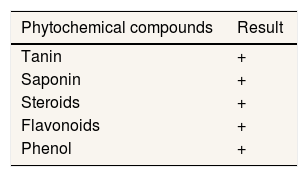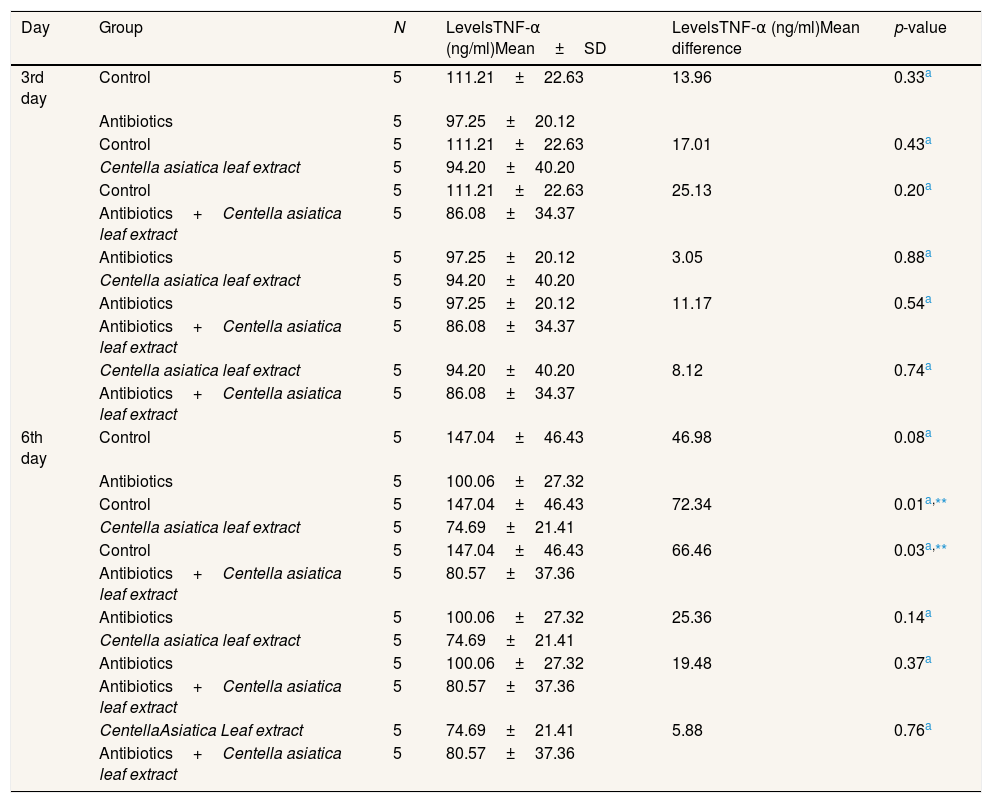
The 3rd International Nursing and Health Sciences Students and Health Care Professionals Conference (INHSP)
Más datosThis study aimed to determine the effectiveness of Centella asiatica leaf extract to TNF-α levels.
MethodsThere were four treatment groups (each group consisted of five rats). Group I was given 0.5% Na CMC, group II was given Cefadroxil 45mg/kg WB, Group III C. asiatica leaf extract 100mg/kg BW, and group IV combination Cefadroxil and Centella leaf extract. Each group was given treatment twice for 12h a day for five days.
ResultsTNF-α levels between groups did not significantly affect day three and differed significantly after day 6. On day 3, the control group had a higher TNF-α level of 25.13pg/ml than the group given antibiotics and C. asiatica. While when compared to the group given only C. asiatica leaf extract, the control group was more height of 17.1pg/ml. On the 6th day, this condition was changed. The most significant difference was found in the group given C. asiatica, in which the control group had higher levels of TNF-α 72.34pg/ml than the group receiving C. asiatica. Then, the control group is higher than 66.46pg/ml than those given antibiotics and C. asiatica.
ConclusionC. asiatica leaf extract effectively reduces TNF both given alone and given along with antibiotics. It is potential to be explored into alternative and complementary treatments in mastitis cases with human trials.
The two problems most often experienced by breastfeeding mothers are nipples and sore breasts and reduced milk production. The common causes of sore nipples and breasts are mastitis. Prospective cohort studies report the incidence of mastitis ranging from 10% to 27%. Occurrences of 3–11% of mastitis cases can progress to breast abscesses. Mastitis is most often caused by Staphylococcus aureus, about 20% of breastfeeding mothers, and the initial cause of the development of breast abscesses.1–4
S. aureus releases several toxins from other endotoxins. Several other components found in its cell walls, such as peptidoglycan and lipoteichoic acid (LTA), can respond to inflammatory responses and are immediately responded to by macrophages using proinflammatory cytokines such as TNF-α and Interleukin 1-Beta (IL-1β). TNF-α is the main cytokine in the acute inflammatory response to bacteria and other microbes, severe infection against the production of large amounts of TNF-α, which results in a systemic reaction.5,6
Early management of mastitis involves general steps to improve the flow of breastfeeding and reduce inflammation. Various drugs used to control and suppress inflammation, such as steroid drugs, nonsteroidal anti-inflammatory drugs, and immunosuppressants, which is minimum doze are adequate, high efficacy, and few side effects. Frequently, postpartum mothers aspire to natural ingredients as natural anti-inflammatory drug therapy to achieve an increase in pharmacological responses with low side effects. Studies currently use anti-inflammatory ingredients from nature. Centella asiatica has been used as an anti-inflammatory treatment. Its leaf extract has shown high anti-oxidant, anti-proliferative, and has the extra ability to regulate inflammatory cytokines, cell death; and It is effective as an anti-diabetic and antimicrobial herb.7–10
C. asiatica as an anti-inflammatory in mastitis is still rarely studied, and this study aimed to analyze the effectiveness of C. asiatica leaf extract to TNF-α levels in mammals of Sprague Dawley mice induced by S. aureus. This is expected to be considered in the treatment of mastitis through traditional medicine from the use of plants around us and easily obtained.
MethodsThe ethical commission has approved this research of the medicine faculty, Hasanuddin University.
Research locationResearch location at the Animal Entomology Laboratory of the Faculty of Medicine, Hasanuddin University, Biopharmaceutical Laboratory, Faculty of Pharmacy of Hasanuddin University, Laboratory of the Faculty of Pharmacy, Muslim University of Indonesia for drying and extracting plants, and in the Microbiology Laboratory at Hasanuddin University Hospital. Measurement of TNF-α levels. The research design used was laboratory research with the design of Posttest Only Control Group Design.
ProcedureAll samples of Sprague Dawley (Rattus norvegicus) female white mice were grounded in groups at the Entomology Laboratory of Hasanuddin University. They got the same standard of food and drinking water. S.aureus will induce mice 0.2ml×108 CFU bacteria in one of their mammae on the first day and then on the second day gave a dose of 2×1 with the suspension of Na CMC 0.5%, cefadroxil 9mg, extract of C. asiatica leaf 100mg/kg BW, and a combination of cefadroxil 9mg and C. asiatica leaf extract 100mg/kg BW. Blood samples were taken on day three and day six after treatment. Then the preparation of plasma specimens using EDTA, followed by conducting a centrifuge with a speed of 2000–3000RPM for 15min, then the obtained plasma is stored in a refrigerator with a temperature of −20°C. Examination of TNF-α levels using a microplate reader (ELISA reader) at a wavelength of 450nm. TNF-α levels examination was using the ELISA.
ResultC. asiatica leaves extracted by maceration extract obtained with a weight of 170g. Based on the results of phytochemical screening, it showed that C. asiatica leaf extract from South Sulawesi, Wajo Regency contained tannin, saponins, steroids, flavonoids, and phenols (Table 1).
In general, the mean TNF-α between groups did not have a significant difference (p=0.630, p>0.05) on day 3 and differed significantly after day 6 (p=0.018, p<0.05). Although there was no significant difference on day three, the control group had the highest levels of TNF-α (111.21pg/ml) levels, and the lowest group was given antibiotics and C. asiatica (86.08pg/ml). On day six the control group remained the highest and experienced an increase (147.04pg/ml) and the antibiotic and C. asiatica group (80.57pg/ml) (Table 2).
TNF analysis on day 3 and day 6 after Centella asiatica administration.
| TNF-α (pg/ml) | Group | n | TNF-α levels (pg/ml) | Standard deviation | p-value |
|---|---|---|---|---|---|
| 3rd day | Control | 5 | 111.21 | 22.63 | 0.630a |
| Antibiotics | 5 | 97.25 | 20.12 | ||
| Centella asiatica leaf extract | 5 | 94.20 | 40.40 | ||
| Antibiotics+Centella asiatica leaf extract | 5 | 86.08 | 34.37 | ||
| 6th day | Control | 5 | 147.04 | 46.43 | 0.018a |
| Antibiotics | 5 | 100.06 | 27.32 | ||
| Centella asiatica leaf extract | 5 | 74.69 | 21.41 | ||
| Antibiotics+Centella asiatica leaf extract | 5 | 80.57 | 37.36 |
After being analyzed in more detail, the data showed that on day 3, the control group had a higher TNF-α level of 25.13pg/ml compared to the group given antibiotics and C. asiatica, while when compared to the group given only C. asiatica, the control group was more height of 17.1pg/ml (Table 3). On the 6th day, this condition was changed. The most significant difference found in the group given C. asiatica, the control group had higher levels of TNF-α 72.34pg/ml than the group receiving C. asiatica only (p=0.01, p<0.05). Furthermore, then a control group is higher 66.46pg/ml compared to those given antibiotics and C. asiatica (p=0.03, p<0.05) (Table 3).
Analysis of differences in TNF-α Levels between groups on the 3rd and sixth days.
| Day | Group | N | LevelsTNF-α (ng/ml)Mean±SD | LevelsTNF-α (ng/ml)Mean difference | p-value |
|---|---|---|---|---|---|
| 3rd day | Control | 5 | 111.21±22.63 | 13.96 | 0.33a |
| Antibiotics | 5 | 97.25±20.12 | |||
| Control | 5 | 111.21±22.63 | 17.01 | 0.43a | |
| Centella asiatica leaf extract | 5 | 94.20±40.20 | |||
| Control | 5 | 111.21±22.63 | 25.13 | 0.20a | |
| Antibiotics+Centella asiatica leaf extract | 5 | 86.08±34.37 | |||
| Antibiotics | 5 | 97.25±20.12 | 3.05 | 0.88a | |
| Centella asiatica leaf extract | 5 | 94.20±40.20 | |||
| Antibiotics | 5 | 97.25±20.12 | 11.17 | 0.54a | |
| Antibiotics+Centella asiatica leaf extract | 5 | 86.08±34.37 | |||
| Centella asiatica leaf extract | 5 | 94.20±40.20 | 8.12 | 0.74a | |
| Antibiotics+Centella asiatica leaf extract | 5 | 86.08±34.37 | |||
| 6th day | Control | 5 | 147.04±46.43 | 46.98 | 0.08a |
| Antibiotics | 5 | 100.06±27.32 | |||
| Control | 5 | 147.04±46.43 | 72.34 | 0.01a,** | |
| Centella asiatica leaf extract | 5 | 74.69±21.41 | |||
| Control | 5 | 147.04±46.43 | 66.46 | 0.03a,** | |
| Antibiotics+Centella asiatica leaf extract | 5 | 80.57±37.36 | |||
| Antibiotics | 5 | 100.06±27.32 | 25.36 | 0.14a | |
| Centella asiatica leaf extract | 5 | 74.69±21.41 | |||
| Antibiotics | 5 | 100.06±27.32 | 19.48 | 0.37a | |
| Antibiotics+Centella asiatica leaf extract | 5 | 80.57±37.36 | |||
| CentellaAsiatica Leaf extract | 5 | 74.69±21.41 | 5.88 | 0.76a | |
| Antibiotics+Centella asiatica leaf extract | 5 | 80.57±37.36 |
Data and analysis in this study show TNF-α levels between groups did not have a significant on day three and differed significantly after day 6. On day 3, the control group had a higher TNF-α level of 25.13pg/ml than the group given antibiotics and C. asiatica, while the group given only C. asiatica the control group was more height of 17.1pg/ml. On the 6th day, this condition was changed. The most significant difference was found in the group given C. asiatica; the control group had higher levels of TNF-α 72.34pg/ml than the group receiving C. asiatica. Then, the control group is higher than 66.46pg/ml than those given antibiotics and C. asiatica.
Severe infections could trigger the production of large amounts of TNF-α and cause systemic reactions. Low levels of TNF-α works against leukocytes and endothelium, inducing acute inflammation, moderate level of TNF-α plays a role in systemic inflammation, and at high levels of TNF-α causes pathological abnormalities of septic shock. TNF-α has many biological effects, including migrating neutrophils and monocytes to the infection site and activating these cells to eliminate microbes. Stimulates macrophages to secrete chemokines and induces chemotaxis and leukocyte deposition. and stimulates mononuclear phagocytes to secrete IL-1 with the same effect as TNF-α.11
The most important compound in C. asiatica leaves is triterpenoid, which strengthens and improves skin cells’ repair, stimulates blood cells, the immune system, and as a natural antibiotic. Research shows effective anti-inflammatory activity in Centella asiatica extract in various cases, both in healing wounds involving acute and chronic bacteria and inflammation due to a systemic immune response.12–19
ConclusionC. asiatica leaf extract is effective in reducing TNF-α both given alone and given along with antibiotics. C. asiatica leaf extract has the potential to be explored into alternative and complementary treatments in mastitis cases with human trials.
Conflicts of interestThe authors declare no conflict of interest.
Peer-review under responsibility of the scientific committee of the 3rd International Nursing, Health Science Students & Health Care Professionals Conference.
















